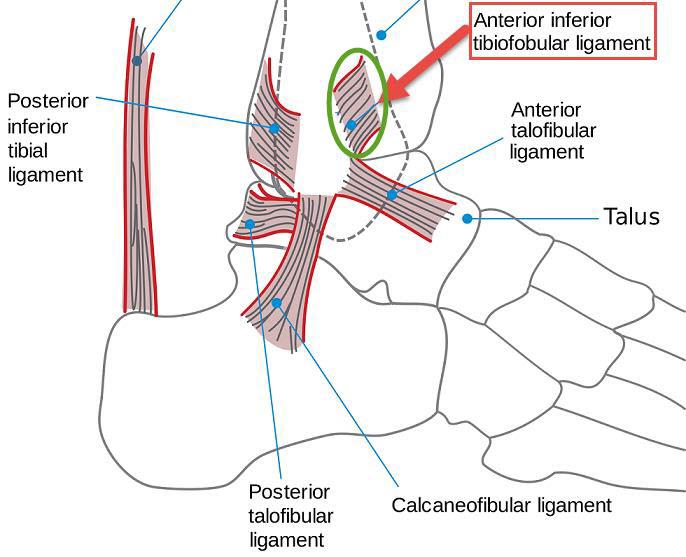The ankle is a hinge joint that connects the foot and the leg, allowing up and down movement. The tibia and fibula bones of the leg form a slot where the talus bone of the foot fits between them. The talus is held to the tibia and fibula by ligaments.
The anterior tibiofibular ligament is often referred to as the high ankle ligament. This ligament slants downward, distally and laterally, between the margins of the fibula and tibia. It’s a point just above the ankle joint where these two bones meet, and the ligament holds the fibula and tibia bones together (syndesmosis). It's important to have stability between the tibia and fibula at this level, because walking and running creates a great deal of force at this junction. Ligament injury of the upper ankle joint is much less common than a traditional ankle sprain.
Anterior Tibiofibular Ligament Injury
An ankle syndesmosis injury (a severe form of ankle sprain), involves damage to supportive ligaments in the ankle. This type of injury is also known as a high ankle sprain because it occurs in the ligaments above the ankle joint. With an ankle syndesmosis injury, the anterior tibiofibular ligament connecting the tibia and fibula bones is sprained. Recovering from even mild injuries of this type can take as long as six to seven weeks.

Why does It Happen?
Many ankle ligament injuries occur when the foot is twisted inwards. When all the body's weight is placed on the lateral ankle ligaments, the anterior tibiofibular ligament stretches or tears resulting in a high sprain of the ankle. Sometimes, pieces of bone may also be torn off with the ligament. In some cases, this twisting force on the ankle can cause other damage. The bones around the ankle may become broken, a piece of the cartilage may be ripped away, other ligaments connecting bones in the foot may be torn or sprained, or the tendons around the ankle joint may be damaged.
What does It Feel Like?
The more severe sprains of the ankle and foot are syndesmosis injuries, and they may also cause many problems for people trying to return to normal activity. When you sprain your ankle, you will feel acute and localized pain on the side of the injured ankle. Mild and moderate syndesmosis sprains can feel like a typical sprained ankle at first. Symptoms include swelling and pain on the outside of the ankleand may be accompanied by discoloration and bruising of the skin. The pain radiates upward along the side of the lower leg, and the ankle may feel unstable and weak.
Diagnosis
The diagnosis of anterior tibiofibular ligament injury is usually done by examining the ankle. The physician moves the ankle in different positions to check the functionality of the ligament around the ankle. The ligament is stressed by holding the lower leg still, while turning the ankle outward. Another test is performed by holding the calf just above the ankle and squeezing it. Any pain associated with this squeeze test is the marker of a syndesmosis ligament injury. If a syndesmosis injury is suspected, X-rays are then used to determine its severity, and an enlarged gap between the tibia and fibula will confirm the diagnosis.
Treatments When Anterior Tibiofibular Ligament Is Injured
1. RICE
Many sprained ankles are fairly minor injuries, and typically get better with simple self-care treatment. The acronym "RICE" can help people remember the basic treatment for a sprained joint:
- Rest: Take the weight off the injured joint as much as possible for a couple of days.
- Ice: Usean ice pack to reduce the swelling, applied for 10 -15 minutes, 3-4 times a daily.
- Compression: Using bandage or strapping to help reduce the swelling.
- Elevation: By resting with the injured ankle above the height of the body to allow swelling to drain away into the bloodstream.
2. Medications
Other treatment may include a mild pain medication and/or anti-inflammatory drugs such as ibuprofen. Unlike a typical ankle sprain, physicians are more likely to recommend the use of crutches for several weeks if a syndesmosis sprain is diagnosed, andan ankle brace is worn during the recovery period.
3. Rehabilitation Exercises
As the ankle heals, they also begin a series of rehabilitation exercises to strengthen the outer ankle muscles and to maximize balance. However, if there is a complete rupture of the anterior tibiofibular ligament, it usually occurs along with a dislocation or fracture in the syndesmosis joint. Whenever this happens, it can cause ankle instability, which may require surgery.
4. Surgery
- Screw Fixation: Surgery for a syndesmosis injury is designed to repair the separation between the tibia and fibula. If there are no barriers keeping the tibia and fibula apart, the surgeon may simply need to place screws through the two bones holding them together while the ligaments heal.Surgeons typically use a large headed screw. This provides for easy removal of the screw after two or three months.
- Open Incision: If the tibia and fibula are separated by debris, the surgeon may have to make an incision on the front edge of the ankle. This will allow the surgeon to find and remove any scar tissue or other debris that are keeping the bones apart.
In both procedures, X-rays of both ankles are taken after the screws are in place. Comparing the X-rays lets the surgeon see if the space between the tibia and fibula is now the same on both sides.
